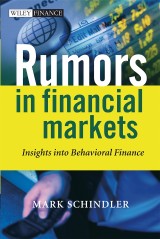Details

Rumors in Financial Markets
Insights into Behavioral FinanceThe Wiley Finance Series, Band 413 1. Aufl.
|
50,99 € |
|
| Verlag: | Wiley |
| Format: | |
| Veröffentl.: | 04.04.2007 |
| ISBN/EAN: | 9780470510339 |
| Sprache: | englisch |
| Anzahl Seiten: | 210 |
DRM-geschütztes eBook, Sie benötigen z.B. Adobe Digital Editions und eine Adobe ID zum Lesen.
Beschreibungen
On the trading floor, all action is based on news, therefore rumors in financial markets are an everyday phenomenon. Rumors are the oldest mass medium in the world and their nature is still difficult to grasp. Scientifically, not much is known about rumors, especially in the financial markets, where their consequences can have real money consequences. Rumors in Financial Markets provides a fresh insight to the topic, combining the theory of Behavioral Finance with that of Experimental Finance--a new and innovative scientific method which observes real decision makers in a controlled, clearly structured environment. Using the results from surveys and experiments, the author argues that rumors in the context of financial markets are built on three cornerstones: Finance, Psychology and Sociology. The book provides insights into how rumors evolve, spread and are traded on and provides explanations as to why volatility rockets, strong price movements, herding behavior for example, occur for apparently no good reason.
<b>List of Symbols.</b> <p><b>Preface.</b></p> <p><b>1 Introduction.</b></p> <p>1.1 Objectives of this book.</p> <p>1.2 Structure of this book.</p> <p>1.3 Research methodology.</p> <p><b>2 Definitions and Characteristics of Rumors.</b></p> <p>2.1 Definitions.</p> <p>2.2 Historical background to studies on rumors.</p> <p><b>3 Rumors and the Theory of Finance.</b></p> <p>3.1 Rumors and Behavioral Finance.</p> <p>3.2 Rumors and rational behavior.</p> <p>3.3 Empirical studies of rumors in the stock market.</p> <p>3.4 Review of models on rumors.</p> <p>3.5 Ethnographical studies.</p> <p><b>4 Legal Aspects of Rumors in Financial Markets.</b></p> <p>4.1 Rumors in financial markets and insider trading.</p> <p>4.2 Review of models on insider trading.</p> <p>4.3 Rumors in financial markets and price manipulation.</p> <p>4.4 Review of models on market manipulation.</p> <p><b>5 Survey of Rumors in Financial Markets.</b></p> <p>5.1 The survey and its intention.</p> <p>5.2 Participant profile.</p> <p>5.3 Development of rumors.</p> <p>5.4 Spreading of rumors.</p> <p>5.5 Belief in rumors.</p> <p>5.6 Network formation.</p> <p>5.7 Trading on rumors.</p> <p>5.8 Rumors versus information.</p> <p>5.9 Conclusions from the survey.</p> <p><b>6 Rumor Experiments.</b></p> <p>6.1 Why use experiments as a research methodology?</p> <p>6.2 Methodological pre-considerations.</p> <p>6.3 Review of previous rumor experiments.</p> <p>6.4 First stage experiments: Ambiguity aversion in a financial market.</p> <p>6.5 Second stage experiments: Varying rumor messages.</p> <p>6.6 Third stage experiments: Testing herd behavior.</p> <p>6.7 Fourth stage experiments: Communication.</p> <p><b>7 Conclusions and Outlook.</b></p> <p><b>Appendices.</b></p> <p>Appendix I.</p> <p>Appendix I.1: Formal presentation of preference relations and choice rules.</p> <p>Appendix I.2: Formal presentation of preference relations with utility functions.</p> <p>Appendix II.</p> <p>Appendix II.1: Experimental instructions for the rumor setting with an auctioneer (experiments 1 and 2).</p> <p>Appendix II.2: Experimental instructions for the rumor setting with a batch auction (experiments 3 and 4).</p> <p>Appendix II.3: Experimental instructions for the rumor setting in a continuous double auction (experiments 5 to 12).</p> <p>Appendix III.</p> <p>Appendix III.1: Second stage experimental instructions.</p> <p>Appendix IV.</p> <p>Appendix IV.1: Third stage experimental instructions.</p> <p>Appendix V.</p> <p>Appendix V.1: Fourth stage experimental instructions.</p> <p>Appendix V.2: First two message levels.</p> <p><b>Notes.</b></p> <p><b>References.</b></p> <p><b>Index.</b></p>
<b>Mark Schindler</b> has written his PhD on "Rumors in Financial Markets" at the Institute for Empirical Research in Economics at the University of Zurich under the supervision of Prof. Thorsten Hens and Prof. Ernst Fehr. Formerly he was working for Arthur Andersen in the area of Financial and Commodities Risk Consulting. He is currently a Funds of Hedge Funds manager for Bank Leu in Zurich.
On the trading floor, all action is based on news, therefore rumors in financial markets are an everyday phenomenon. Rumors are the oldest mass medium in the world and their nature is still difficult to grasp. Scientifically, not much is known about rumors, especially in the financial markets, where their consequences can have real money consequences. <i>Rumors in Financial Markets</i> provides a fresh insight to the topic, combining the theory of Behavioral Finance with that of Experimental Finance—a new and innovative scientific method which observes real decision makers in a controlled, clearly structured environment. Using the results from surveys and experiments, the author argues that rumors in the context of financial markets are built on three cornerstones: Finance, Psychology and Sociology. The book provides insights into how rumors evolve, spread and are traded on and provides explanations as to why volatility rockets, strong price movements, herding behavior for example, occur for apparently no good reason.
Diese Produkte könnten Sie auch interessieren:

Counterparty Credit Risk, Collateral and Funding

von: Damiano Brigo, Massimo Morini, Andrea Pallavicini

69,99 €
















